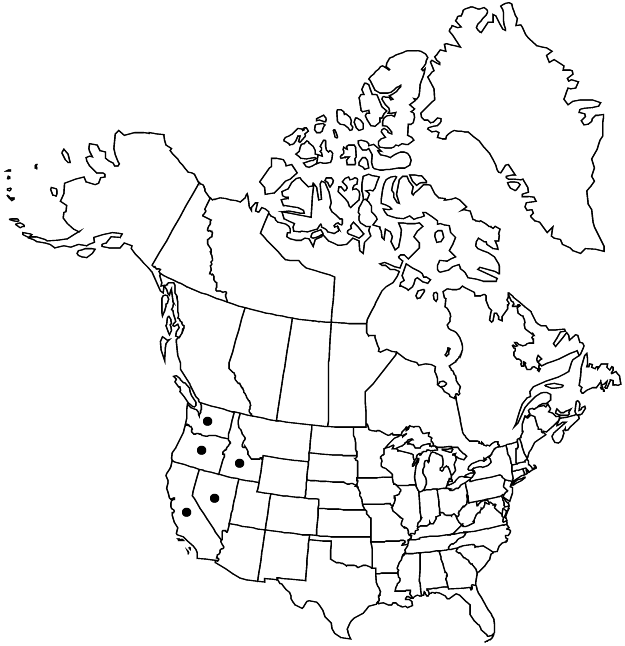Difference between revisions of "Eriogonum strictum var. anserinum"
in R. J. Davis, Fl. Idaho, 249. 1952.
FNA>Volume Importer |
imported>Volume Importer |
||
| (4 intermediate revisions by one other user not shown) | |||
| Line 1: | Line 1: | ||
{{Treatment/ID | {{Treatment/ID | ||
|accepted_name=Eriogonum strictum var. anserinum | |accepted_name=Eriogonum strictum var. anserinum | ||
| − | |accepted_authority=(Greene) S. Stokes | + | |accepted_authority=(Greene) S. Stokes |
|publications={{Treatment/Publication | |publications={{Treatment/Publication | ||
|title=in R. J. Davis, Fl. Idaho, | |title=in R. J. Davis, Fl. Idaho, | ||
| Line 8: | Line 8: | ||
}} | }} | ||
|common_names=Goose Lake wild buckwheat | |common_names=Goose Lake wild buckwheat | ||
| − | |basionyms={{Treatment/ID/ | + | |special_status={{Treatment/ID/Special_status |
| + | |code=E | ||
| + | |label=Endemic | ||
| + | }} | ||
| + | |basionyms={{Treatment/ID/Basionym | ||
|name=Eriogonum anserinum | |name=Eriogonum anserinum | ||
|authority=Greene | |authority=Greene | ||
| + | |rank=species | ||
| + | |publication_title=Pittonia | ||
| + | |publication_place=4: 320. 1901 | ||
}} | }} | ||
|synonyms={{Treatment/ID/Synonym | |synonyms={{Treatment/ID/Synonym | ||
|name=Eriogonum ovalifolium subsp. flavissimum | |name=Eriogonum ovalifolium subsp. flavissimum | ||
|authority=(Gandoger) S. Stokes | |authority=(Gandoger) S. Stokes | ||
| + | |rank=subspecies | ||
}} {{Treatment/ID/Synonym | }} {{Treatment/ID/Synonym | ||
|name=Eriogonum proliferum subsp. anserinum | |name=Eriogonum proliferum subsp. anserinum | ||
|authority=(Greene) Munz | |authority=(Greene) Munz | ||
| + | |rank=subspecies | ||
}} {{Treatment/ID/Synonym | }} {{Treatment/ID/Synonym | ||
|name=Eriogonum strictum subsp. anserinum | |name=Eriogonum strictum subsp. anserinum | ||
|authority=(Greene) S. Stokes | |authority=(Greene) S. Stokes | ||
| + | |rank=subspecies | ||
}} {{Treatment/ID/Synonym | }} {{Treatment/ID/Synonym | ||
|name=Eriogonum strictum var. flavissimum | |name=Eriogonum strictum var. flavissimum | ||
|authority=(Gandoger) C. L. Hitchcock | |authority=(Gandoger) C. L. Hitchcock | ||
| + | |rank=variety | ||
}} | }} | ||
|hierarchy=Polygonaceae;Polygonaceae subfam. Eriogonoideae;Eriogonum;Eriogonum subg. Eucycla;Eriogonum strictum;Eriogonum strictum var. anserinum | |hierarchy=Polygonaceae;Polygonaceae subfam. Eriogonoideae;Eriogonum;Eriogonum subg. Eucycla;Eriogonum strictum;Eriogonum strictum var. anserinum | ||
| Line 48: | Line 59: | ||
-->{{#Taxon: | -->{{#Taxon: | ||
name=Eriogonum strictum var. anserinum | name=Eriogonum strictum var. anserinum | ||
| − | + | |authority=(Greene) S. Stokes | |
| − | |authority=(Greene) S. Stokes | ||
|rank=variety | |rank=variety | ||
|parent rank=species | |parent rank=species | ||
| Line 62: | Line 72: | ||
|publication title=in R. J. Davis, Fl. Idaho, | |publication title=in R. J. Davis, Fl. Idaho, | ||
|publication year=1952 | |publication year=1952 | ||
| − | |special status= | + | |special status=Endemic |
| − | |source xml=https:// | + | |source xml=https://bitbucket.org/aafc-mbb/fna-data-curation/src/2e0870ddd59836b60bcf96646a41e87ea5a5943a/coarse_grained_fna_xml/V5/V5_641.xml |
|subfamily=Polygonaceae subfam. Eriogonoideae | |subfamily=Polygonaceae subfam. Eriogonoideae | ||
|genus=Eriogonum | |genus=Eriogonum | ||
Latest revision as of 22:12, 5 November 2020
Plants loose mats, 2–4 dm wide. Leaf blades usually ovate, 0.5–2 cm, grayish-tomentose or floccose on both surfaces. Inflorescences 1–3(–5) cm; branches tomentose to floccose. Involucres 4–5.5 × 4–5 mm, tomentose. Flowers 3–4.5 mm; perianth yellow.
Phenology: Flowering May–Aug.
Habitat: Sandy to gravelly flats and slopes, sagebrush communities, conifer woodlands
Elevation: (100-)400-2600 m
Distribution

Calif., Idaho, Nev., Oreg., Wash.
Discussion
Variety anserinum is the yellow-flowered phase of the species; it and var. proliferum are only occasionally found together. This taxon is widely scattered in most of its range in northeastern California, southwestern Idaho, northern Nevada, eastern Oregon, and eastern Washington. It is common mainly from south-central Oregon south into northwestern Nevada and eastern California. The plants are attractive and are occasionally seen in cultivation.
Selected References
None.